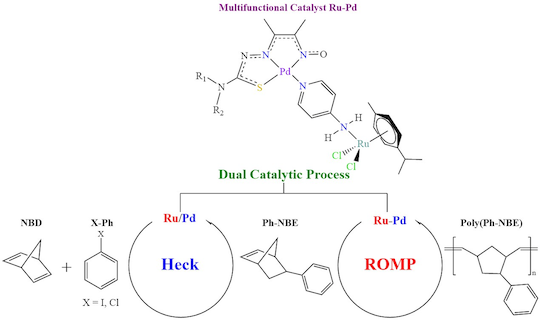"Heterobimetallic Pd-Ru Catalysts for the Synthesis of Functionalized Polynorbornenes via Reductive Heck/ROMP Reactions"
Thais R. Cruz, Juliana I. P. Maia, Pedro I. S. Maia, Antonio E. H. Machado, Beatriz E. Goi, Valdemiro P. Carvalho-Jr, and Lionel Delaude
 |
source: Submitted for publication
year: 2024
volume:
first page:
last page:
doi:
|

Abstract: Heterobimetallic complexes offer a greater versatility for applications in homogeneous catalysis than their monometallic counterparts. To take advantage of this synergy, three [Pd(N,N,S-TSC)(4-NH2Py)] complexes (mono-PdMe, mono-PdMe,Me and mono-PdPh) were first synthesized from [PdCl2(MeCN)2] and appropriate thiosemicarbazide (TSC) ligand precursors, followed by the addition of 4-aminopyridine (4-NH2Py). The reaction of these mono-PdL complexes with [RuCl2(η6-p-cymene)]2 then afforded three heterobimetallic complexes with the generic formula [{RuCl2(p-cymene)}-μ-{(4-NH2Py)Pd(TSC)}] (Ru-PdMe, Ru-PdMe,Me and Ru-PdPh). All these novel compounds were characterized by elemental analysis, spectroscopic techniques, cyclic voltammetry, and DFT calculations. The molecular structure of mono-PdMe was determined by X-ray diffraction analysis. The Ru-PdL complexes were evaluated as bifunctional catalysts in the reductive Heck coupling of norbornadiene (NBD) with iodobenzene, and the ring-opening metathesis polymerization (ROMP) of phenylnorbornene (Ph-°BE). They were very active for the reductive Heck reaction, reaching yields higher than 90% when a [Pd]/[NBD]/[PhI] ratio of 1/418/1344 was employed at 120 °C. Upon activation with ethyl diazoacetate (EDA), they were also able to polymerize Ph-NBE with yields around 70% using a [Ph-NBE]/[Ru-PdL] ratio of 3000 at 50 °C for 30 min. The Ru-PdMe,Me complex showed the highest activity in the ROMP of Ph-NBE and was successfully applied for mediating the synthesis of poly(Ph-NBE) from NBD via tandem catalysis.
Keywords: Bifunctional Catalysts, Olefin Metathesis, Palladium, Ruthenium, Thiosemicarbazide Ligands
[Full Text] [<< Previous Article] [Back to the List of Publications] [Next Article >>] l.delaude@ulg.ac.be